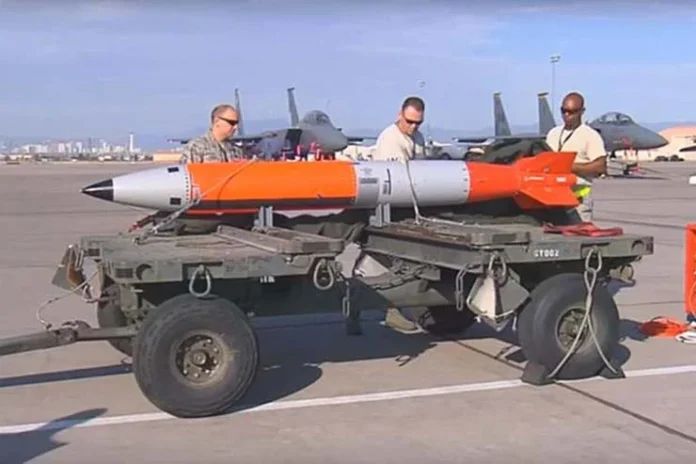Washington: The US Defence Department on October 27 announced the government is moving forward with developing a new version of the B61 nuclear gravity bomb.
The bomb, designated B61-13, would have a yield similar to the B61-7 and replace some of those older gravity bombs, the Pentagon said in its announcement. The B61-7′s yield is higher than the B61-12, the most recent bomb being added to the military’s arsenal.
The Pentagon said the decision to build this weapon was made to reflect the changing security environment in line with the 2022 Nuclear Posture Review. That study said the military needed to modernise its nuclear forces to properly deter its two main nuclear-armed competitors, China and Russia.
The B61-13 will use the same modern safety, security and accuracy features now incorporated into the B61-12, the Pentagon said in a fact sheet accompanying the release. It would also give the president more options to strike “harder and large-area military targets,” the Pentagon said, while the department works to retire legacy bombs such as the B61-7 and B83-1.
Hans Kristensen, a nuclear weapons expert at the Federation of American Scientists who was briefed by the Pentagon on the bomb earlier this week, said the weapon will incorporate the same warheads from the 1980s- and 1990s-era B61-7s, transplanted into the same style casing and tail kit as the B61-12.
Kristensen said the creation of this bomb is likely intended to be a compromise to break a year’s long disagreement between Democrats and Republicans over the fate of the massive, 4-decade-old B83-1 bomb.
Former President Barack Obama sought to get rid of the 1.2-megaton B83-1 — the last megaton bomb left in the country’s nuclear arsenal and one that would explode with 80 times the force of the bomb dropped on Hiroshima in 1945. But his successor, former President Donald Trump, reversed that decision.
President Joe Biden since revived efforts to get rid of the B83. But key Republican lawmakers have objected, saying the B83-1 is needed to strike hard and deeply buried targets.
The maximum yield of the B61-7 — and by extension the new variant — is 360 kilotons, Kristensen said, while the B61-12 has a maximum yield of 50 kilotons.
“This is a sweetener to the hardliners in Congress to basically say: ‘OK guys, you want something with a high yield,” Kristensen said. “ ‘Here’s a small number of them … but you also get one with a tail kit that will be more accurate.’ ”
House Armed Services Committee Chairman Mike Rogers, R-Ala., and Sen. Roger Wicker of Mississippi, the ranking Republican on the Senate Armed Services Committee, said in a statement they welcome the creation of a new B61 variant, but that it “is only a modest step in the right direction.”
“The B61-13 is not a long-term solution, but it will provide our commanders, particularly in [the Pacific and European regions], with more flexibility against these target sets,” Rogers and Wicker said. “As the Strategic Posture Commission recently noted, China and Russia are in a full-on arms race, and the US is running in place. Dramatic transformation of our deterrent posture — not incremental or piecemeal changes — is required to address this threat.”
The Pentagon said the creation of this bomb will not lead to an overall increase in the size of the military’s stockpile. The United States plans to lower the number of B61-12s it will produce by as many B61-13s it builds.
Kristensen said defence officials indicated very few B61-13s are expected to be produced, on the order of a few dozen. He doubted their creation, alongside the retirement of B61-7s, would lead to much, if any, decline in the number of gravity bombs in the United States’ arsenal, which he said is somewhere between 400 and 500.
If the B61-13 is approved and funded by lawmakers, the Energy Department’s National Nuclear Security Administration will produce it.
The Pentagon said in its announcement that modern aircraft would be able to deliver this bomb.
In a follow-up statement, a Pentagon spokesperson said that will include the B-21 Raider stealth bomber the Air Force now has in development with Northrop Grumman. But the US now does not plan to deploy it on the F-35 Joint Strike Fighter, the Pentagon said.
But whether the creation of the B61-13 will ultimately be a positive development is “the million-dollar question,” Kristensen said.









